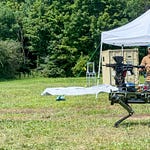It's a blast from the past this week and Jason and Matthew get ready for 2018. Here's what we said back then:
From Star Wars to Battlestar Galactica, few battlefields are as fought over in pop-culture as space. Which makes sense. Since the end of World War Two, people have looked to the stars as the next great frontier of both exploration and warfare.
For the United States, the Space Race was about both prestige and gaining an advantage over its Cold War enemies. And since the Soviet Union launched Sputnik in 1957, peopled have looked to the skies above and wondered if the next great war might take place in literal vacuum.
But according to David Axe, editor-in-chief of War Is Boring, the war in space won’t look anything like what Hollywood has long pictured. Slow moving robots, lasers and logistics will dominate combat above the skies.
In this week’s War College, Axe dispels the popular myths of space as a battlefield and let’s us know what’s really going on in Earth’s orbit. Axe describes how to weaponize existing satellites, the missiles America and China have developed to knock those satellites out of the sky and the low-cost plans the Pentagon has to maintain its edge in the stratosphere.
You can listen to War College on iTunes, Stitcher, Google Play or follow our RSS directly. You can reach us on our new Facebook page: https://www.facebook.com/warcollegepodcast/; and on Twitter: @War_College.
See acast.com/privacy for privacy and opt-out information.












